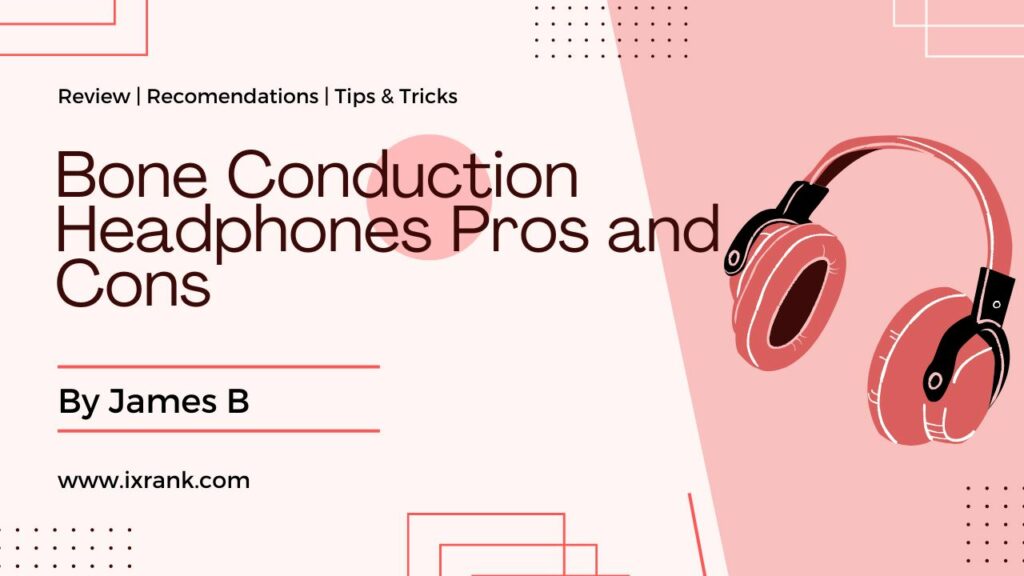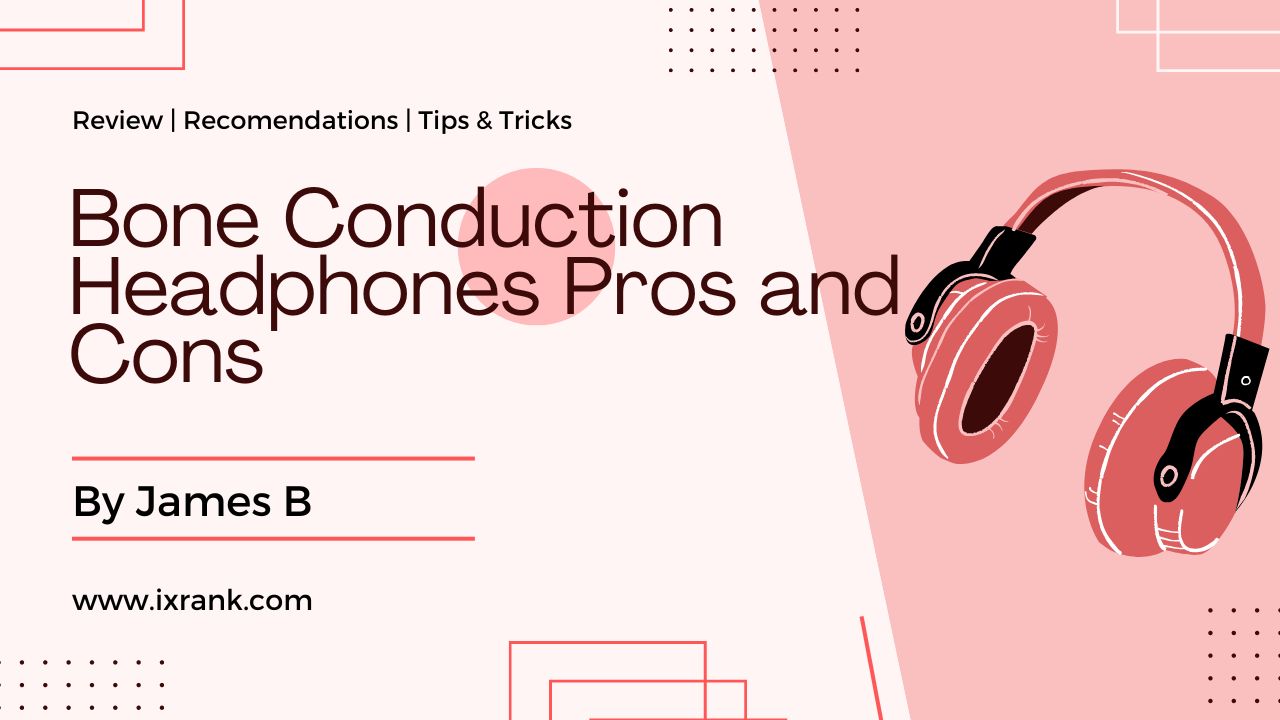Have you ever wondered that how good it would be if you could hear with your bones rather than inserting headphones or earphones into your ears? Well, no need to wonder anymore because technology has brought bone-conduction headphones.
Bone-conduction technology has been around for a while now, but bone-conduction headphones have become common in recent times.
Bone-conduction headphones were typically introduced for athletes but nowadays, everyone is using these headphones. However, their work differs greatly from traditional headphones.
We will discuss them from the scratch and if you’re thinking of buying bone-conduction headphones, then don’t decide yet because we are going to discuss bone-conduction headphones’ pros and cons.

Table of Contents
What are Bone-Conduction Headphones?
As the name (bone-conduction) describes, these headphones have something to do with bones and here the soundwave travels via bones. Rather than covering the ears or going over the ears or going inside the ears, these headphones sit on the temples on each side of the ear. Let’s get into a little bit of detail about these (bone-conduction) headphones.
How Traditional Headphones Work?
The traditional headphones send the sound from the outer ear, through the ear canal, to the eardrum, vibrate the bones of hearing (which are also known as ossicles) and then stimulate the hair cells inside of the cochlea.
If traditional headphones are working correctly and you’re hearing a clear sound, this means that all these systems are working correctly in your body.
How the Working of Bone-Conduction Headphones Differs from Traditional Headphones?
With bone-conduction headphones, the sound can bypass all the outer and middle ear components for stimulating the hearing. Bone-conduction headphones work by stimulating the skull which creates a vibration and that vibration moves the hair cells directly inside of the cochlea.
That way, the users can hear people talking to them and listening to the music.
Today’s Agenda
It’s a good thing that with bone-conduction headphones, the sound can stimulate the cochlea directly. But if sound can stimulate the cochlea by going through the whole ear system with traditional headphones, then what’s the need for purchasing bone-conduction headphones?
We’ll answer this question with the help of bone conduction headphones benefits. Not only that, but we will discuss bone conduction headphones’ side effects since we are not sponsored by anyone.
That way, at the end of this article, the readers will have a clear perspective about bone-conduction headphones. So, without any further delay, let’s begin!
Bone Conduction Headphones Pros and Cons
We all know that everything in this world has some advantages and some disadvantages and bone-conduction headphones are no exception. In the end, it all depends on how a user uses a particular thing. So, let’s start with the benefits of bone-conduction headphones.
Pros of Bone-Conduction Headphones
We will discuss some scenarios where bone-conduction headphones can prove better than traditional headphones.
1. Tech Enthusiast
Even in 2021, bone-conduction headphones are not mainstream yet, and even when you go to the gym or for swimming, you won’t see most people wearing such type of headphones.
So, if you are tech-savvy and you have bought these just because these headphones look cooler, you will surely get asked a few questions, when you wear these (bone-conduction) headphones in public.
2. CHL
CHL stands for Conductive Hearing Loss and in CHL, the sound is unable to transmit to the cochlea or the inner ear because the outer and the middle ear have something wrong with them. The main reasons for CHL are earwax, hole in the eardrum, the bones of hearing become dislodged, middle-ear infection, fluid behind the ear, etc.
A person with CHL can’t use traditional headphones because those headphones can’t pass the sound well and the user can’t hear the sound well. That’s where the bone-conduction headphones work well because it eliminates the factor of the outer ear and middle ear.
But the cochlea of a user should be healthy enough so that he can hear the sound well through bone-conduction headphones. Otherwise, these (bone-conduction) headphones will be of no use.
3. Sitting on the Temples
The good thing about these (bone-conduction) headphones is they don’t need to go inside of the ear canals for their working because they don’t use middle ears or ear canals to transmit the sound. These headphones stimulate that bone directly, which stimulates the cochlea and this makes those hair cells send that signal directly to the brain of the user.
Bone-conduction headphones leave the ears of their users exposed and tend to wrap around their ears rather than going inside their ears, so if you have issues like ear wax, then you don’t need to worry while wearing bone-conduction headphones.
4. Situation Awareness
As bone-conduction headphones don’t go inside the ear or cover the ear, they can create situational awareness for their users and by wearing these, users can stay aware of what is happening around them.
5. Less-Chance of Damaging Ears
With bone-conduction headphones, the users will have fewer chances of damaging their hearings but that doesn’t mean that these headphones are 100% safe, because listening to high-volume in any headphones may damage your hearing.
So, never ignore the message on your device that says “Listening to High-Volume May Damage Your Hearing”.
However, compared to traditional (over-the-ear or in-the-ear) headphones, bone-conduction headphones reduce the chances of hearing loss. So, it’s safe to say that these are bone conduction hearing aid headphones.
Cons of Bone-Conduction Headphones
Some areas where bone-conduction headphones lack as compared to the traditional headphones.
1. On-Par Performance
As compared to the traditional headphones or earbuds, these (bone-conduction) headphones give an on-par performance in terms of sound quality and these are not up to the standard of premium traditional headphones or earbuds.
For a user who doesn’t have sound quality as his top priority while buying headphones, these can be good but for a sound-savvy person, these will do no good.
2. Uncomfortable
Bone-conduction headphones work by pressing the transducers hard enough into your skull for creating a vibration that your ears can pick and you can hear the sound and this pressure might be uncomfortable for some users.
However, the pressure is not high-intensity pressure and if you are doing something challenging like a hard swimming or gym session, you will hardly feel the pressure. Still, for a traditional headphones user, it might be uncomfortable. But in the end, it depends upon the anatomy of a specific person.
3. Listening Loud is not an Option
If you listen to the bone-conduction headphones in full volume, you will experience sound leakage and the person sitting next to you can easily listen to what you’re hearing.
However, if you want to attend the call in a noisy place using bone-conduction headphones, you can use the noise-canceling factor as there is bone conduction noise canceling headphones that will be suitable for answering calls in a crowded place.
4. Cost
Unlike traditional headphones or earbuds, bone-conduction headphones work differently, so no doubt why they are expensive than traditional headphones. If you are thinking of buying premium bone-conduction headphones, it can cost you around $150-$200.
Final Words and Recommendations
Trying bone-conduction headphones for the first time might be uncomfortable for some users but we hope that after reading these pros and cons, you can clearly think whether bone-conduction headphones are made for you or not.
We don’t want to defame a particular technology but these are some advantages and disadvantages we’ve observed during our testing. Moreover, various manufacturers have made a lot of improvements in recent times in the bone-conduction headphones lineup and this technology will get a lot better as time passes by.
Nowadays, you can get bone conduction headphones from $25 to $200. AfterShokz is one of the most popular manufacturers of bone-conduction headphones and AfterShokz Aeropex is its number one model according to most experts, but if you want bone-conduction headphones just for calls; then go for AfterShokz OpenComm.
However, these are premium bone-conduction headphones and if you are looking for a budget pick, then Vidonn bone conduction headphones will be good for you.
ixRank.com having a team of experts who reviewed different products related to technology team members background is technology-related like software engineers and computer programmer, digital marketer, and stunning writers.
